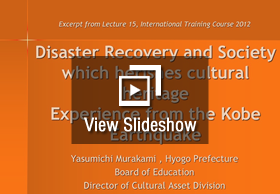

This section highlights the role that repairs and conservation of heritage plays in post disaster recovery, and how tangible and intangible values of cultural heritage may be utilised as an asset. It emphasises minimising intervention and preventing demolition of heritage structures as far as possible. It stresses maintaining a delicate balance between safety considerations and maintaining values, authenticity and integrity of cultural heritage.
The instructor can use several case examples or a single case study linking to previous sections in this module to highlight the importance of protecting the values of cultural heritage while giving due consideration to safety during post disaster recovery.
Damage Assessment and Post Disaster recovery Planning, International Training Course 2011
Instructor: Yasumichi Murakami
Duration: 80 minutes
Read More...

The lecture may be supported by a site visit to an area where such activities are either underway or completed to highlight various aspects of repairs, restoration and retrofitting. The focus should be on approaches as opposed to giving lessons on technical skills, which may generally not be under the scope of a programme of this nature.
Site Visit to Kobe-shi Kitano-cho Yamamoto-dori District, International Training Course 2012
Instructor: Yasumichi Murakami
Duration: 120 minutes
Read More...
This section focuses on the various approaches and methodologies for preventing and mitigating disaster risks to cultural heritage. This generally involves one or more of the following approaches
Key aspects to be introduced and discussed
A policy of minimal intervention should be retained as much as possible; the values, authenticity and integrity of the cultural heritage should be considered while deciding appropriate mitigation measures. Reviews should be done periodically to the disaster risk management strategy to prevent any unintended impact of risk-reduction activities.
Damage Assessment and Post Disaster recovery Planning, International Training Course 2011
Instructor: Yasumichi Murakami | Duration: 80 minutes
Using a running case study of the Hanshin Awaji Earthquake, several core principles of repair and restoration of cultural heritage were communicated to the participants. This lecture is a continuation of the lecture given in the previous sub-modules. It highlighted the various issues that rose post disaster related to the built heritage as well as the various actions undertaken.
Two critical issues were highlighted during the planning for recovery of heritage buildings in Kobe:
It was concluded that based on priority, the following approaches would be undertaken in order of preference:
1. Additions using traditional techniques and traditional materials.
2. Additions using traditional techniques and techniques derived from them, as well as a combination of traditional and modern materials.
3. Additions using modern techniques and modern materials.
4. Replacements using modern techniques and modern materials.
Each of the above approaches was demonstrated through examples of restoration and retrofitting projects undertaken following the Kobe earthquake.


Site Visit to Kobe-shi Kitano-cho Yamamoto-dori District, International Training Course 2012
Instructor: Yasumichi Murakami | Duration: 120 minutes
The instructor had introduced the secondary case studies of various structures that had been extensively restored after the Great Hanshin Awaji Earthqauke of 1995. Subsequently a site visit to some of these restored and retrofitted structures was organized. Participants were able to observe the results of a long term process of planning and retrofitting techniques through their visits to these structures that have been restored following the earthquake.
